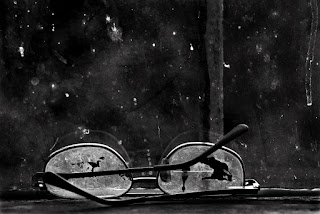"Light to me is perhaps the most profound truth in the universe. My thinking has been deeply affected by the belief that everything is some form of radiant energy." - Wynn Bullock (1905 - 1975)
Wynn Bullock is arguably one of the greatest fine-art photographers to have graced our world with his soulful mind, heart, and eye. He is also one of three photographers (of a bygone generation, relative to mine) that I deeply lament not having had the opportunity to meet and get to know personally (the other two being
Ansel Adams and
Minor White). Though I was certainly alive when Bullock passed away (and I was already "taking pictures"), I was but a young lad of 15, and had yet to appreciate the Buddhist transience of life and everything precious in it. Plenty of time to "get to know the greats..." (or so I thought)
How would my creative life have been different - what alternative paths would I have taken - had there been a chance to learn - and possibly muse with - such extraordinary artists; whose work I have learned to respect and resonate with on ever deeper levels as I grow into the late summer of my own life? Adams first showed me how nature can be seen as its own transcendent reality. And White how the best photographs are those whose "outer appearance" reflect one's "inner perceptions." But it was Bullock, whose work I came to know and admire deeply a few years after studying Adams and White, who (continues to) pave the way for my own creative journey; one that strives to combine - and transcend - the (nominally pseudo-orthogonal) aesthetic, spiritual, and intellectual dimensions of experience, thought, and reality.
Apart from living in slightly different times (I was born 55 years after Bullock) and different places (he on the west coast, I on the east), and apart from the fact that Bullock's work is well-known to almost all photographers and mine to almost none (outside of family, friends, and an occasional tip-of-the-hat from a kind reader of my blog), our respective histories and creative predilections share a few traits; I therefore feel an especially close affinity towards him. For starters, both of us were married twice, the first time rather unsuccessfully in what was more of a "trial" (in both literal and figurative senses), and not-at-all conducive to producing any kind of art - in Bullock's case, I was saddened to learn that his first wife thought his photography was a waste of time (mine was more understanding); she'd sometimes enter his darkroom to tear up his prints in fits of anger! In both cases, our second marriage found us soul-mates and muses.
Bullock's second marriage led to two girls; mine, to two boys.
The most important traits we share have to do with our photography: (1) we are both opportunistic, taking advantage of family trips and outings more than Ansel-Adams-like dedicated month-long trips away from home (reveling primarily in finding and revealing the transcendent nature of everyday reality), (2) we both incessantly experiment with new modes of visual expression (perpetually seeking that extra "spark" to ignite a new line of aesthetic inquiry), and (3) we both heavily ground our photography in intellectual
- sometimes deeply
metaphysical - musings
(invoking images of time, space, reality, illusion, ...); a fact that should be obvious (on my side, at least) to anyone who has perused just the topics of my blog entries, much less their substance ;-) Bullock's
musings may be sampled on his
website (lovingly crafted and kept up-to-date by his eldest daughter, Barbara Bullock-Wilson) and in a few of his books that are still available: (1)
Wynn Bullock: The Enchanted Landscape, Photographs 1940-1975, (2)
Wynn Bullock: Photography a Way of Life, and (3)
Wynn Bullock (Aperture Masters of Photography). (Links to other references are provided below).
And so we come to the point of this blog, which is to introduce interested readers to an extraordinary
new book of Bullock's color abstracts -
Wynn Bullock: Color Light Abstractions - which also serves as a catalog of a traveling exhibition that premiered on May 15, 2010 at the
Center for Photographic Art in Carmel,California. I label this book "new" not only because it has only recently been published (in 2010), but because it contains over 50 color light abstractions that have
rarely before been seen in public! Though Bullock was primarily a black-and-white photographer (another trait we share), he had experimented heavily, in the late 50s and early 60s, with color. Unsatisfied with the color printing at the time, few outside his family and circle of friends ever saw samples of this work, and even then mostly via slide presentations. Inspired and helped by a close family friend (John Hong Hall, to whom the traveling exhibition is dedicated and whose moving story appears in an afterword to the book), the heirs to (and caretakers of) Bullock's work undertook the prodigious task of organizing, restoring, scanning, and printing 50+ year-old Kodachrome color slides.
I will spare readers a "description" of these images, since whatever pale words I may attach to my "experience" of them will so distort their essence - inevitably altering the meaning the images would convey on their own if viewed by your eyes only - that to do so would be an aesthetic injustice on my part. Suffice to say that this collection of color light abstracts is
nothing short of breathtaking! Were one not told of how these surrealistic, other-wordly images came to be (a word or two on that in a second), but was simply presented with the finished portfolio, with only the implicit understanding that the images were obviously produced by a prodigiously gifted photographer, one would be forgiven for believing that it was all "some Photoshop trick," albeit an astoundingly creative - indeed,
visionary - one! The fact that these images were produced c.1960 using everyday objects like broken shards of thick colored glass, beads, jewelry, polarizing filters, and both artificial and natural light, makes this already exquisite portfolio all the more remarkable. A short description of his method appears
here, and also in a superb 30 min documentary on his life and work,
Wynn Bullock: Photographer.
I have written
before of heretofore having only
three epiphanous reactions to photography monographs, to which I simply went
"Wow!" upon seeing, and which fundamentally altered my perceptions of the creative potential of photography as an art form: (1) Bruce Barnbaum's
Visual Symphony (in the 1970s), (2) Fay Godwin's
Land (middle 1980s), and (3) John Sexton's
Recollections (in 2006). To this short list I must now add a fourth, Wynn Bullock's
Color Light Abstractions. This work is, in a word, a
masterpiece!
Postscript: I stumbled across Bullock's color abstractions somewhat synchronistically (at an age close to Bullock's when he first started experimenting with color), insofar as I have recently also embarked on what has turned out to be a multiyear "color experiment" in (what in my case, I call)
"Synesthetic Landscapes" (and that I have
discussed before). Though the specifics of our methods differ, like Bullock, I am essentially driven to photograph
light itself, not the physical forms that light makes visible or otherwise gives shape and texture to. My "color abstract sources" (thus far, at least) have been impromptu / makeshift "in the field" mini studios consisting of
doors or
bottles of rum (among many, many other everyday "things"); the best results are eerily reminiscent of the hyperreal dimensions discovered first by Bullock: realms of fluidic time and space, ineffably infused with mysterious luminescent protoforms of life and consciousness ;-)





















